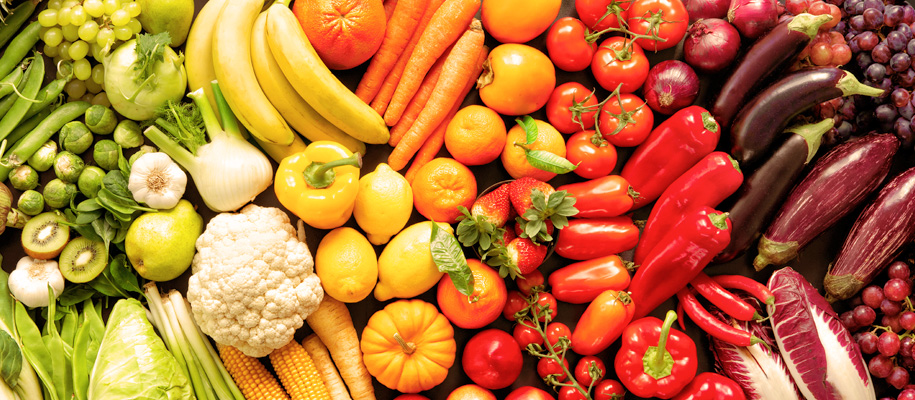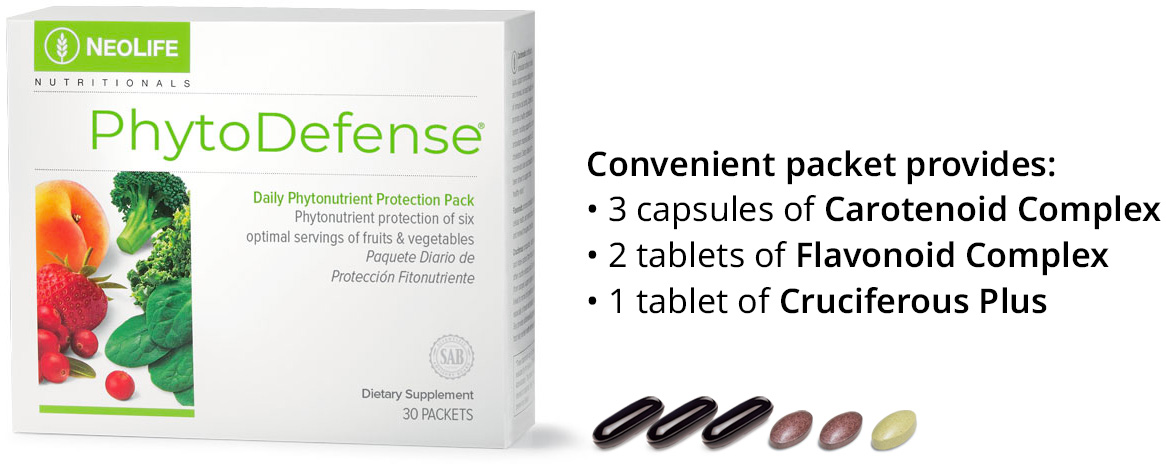
 By Dr. Diane E. Clayton
By Dr. Diane E. Clayton
SAB Member
Why does Fruit and Vegetable Intake Matter?
There is overwhelming evidence that higher fruit and vegetable (F&V) consumption is associated with lower incidence of chronic diseases.1,2 One of today’s biggest focus areas in nutritional research is to explain the reasons why fruit and vegetable intake has such a positive effect on our health. Is it the valuable vitamin and mineral content? The fiber content? Or could it be due to the very diverse array of phytonutrients that F&V contain? Maybe all of these play a role? Naturally, there is a clear need to better understand the protective effects of F&V and their constituent bioactive phytonutrients.†
Efforts to Increase Fruit and Vegetable Intake are Failing Miserably!
Sadly, despite the unanimous health authority recommendations to eat more portions of F&V, most of us are far off the minimum target of 5 portions (or 400g) daily set by the World Health Organization (WHO)2, and very far off the target for optimal benefit, thought to be about 10 portions (800g)!3,4 Around 90% of Americans still fall well short of the daily vegetable intake recommendations, and the figures are even worse for children specifically.4 Furthermore, the nutrient and phytonutrient content of the F&V available to us can vary significantly according to farming methods, handling and storage, processing, and cooking. So even if we eat enough F&V by weight, we may not be getting enough phytonutrients!
Simplifying the Message: “Eat the Rainbow”
To make the message about F&V more attractive, various nutrition guidelines and public health promotion messages recommend “Eating the Rainbow,” said to mean eat a plate of colorful foods at every possible opportunity. The focus on color on our plates can be a simple way to help us towards our 5-10 portions of F&V a day, increasing the diversity and density of phytonutrients. For example, yellow, red, and purple are a sign of flavonoids and carotenoids, orange signals the presence of carotenoids, whereas green is a sign of chlorophylls and organosulfur compounds such as isothiocyanates, but also selected carotenoids. Though not officially part of the rainbow colors, white/brown is also a food color category, represented by onions and garlic, which contain valuable organosulfur phytonutrients.
This color-rich pattern of eating is typified by the Mediterranean diet. This style of eating is for solid reasons very highly recommended by many leading authorities.5 Evidence for the health promoting and pro-longevity properties of the Mediterranean dietary patterns is substantial, and the high content of phytonutrients is often cited as one of the main reasons that this dietary pattern is so beneficial.6
The NeoLife SAB, Pioneers of Phytonutrient Research!
Back in the early 90s, NeoLife scientists focused their efforts on phytonutrient research and formulated three outstanding products: Carotenoid Complex™, Flavonoid Complex™ and Cruciferous Plus™.
The phytonutrient blends in these products were carefully designed to deliver a very wide and meaningful array of protective phytonutrients.* Carotenoid Complex™ delivers a broad variety of different carotenoid members, Flavonoid Complex™ contains members of five flavonoid classes, and Cruciferous Plus™ delivers valuable organosulfur compounds as well flavonoids and terpenes. Taken individually, or in the combined format as PhytoDefense®, these products provide a broad spectrum of phytonutrients from colorful F&V extracts (Table 1).
The SAB, working together with other eminent scientists, conducted a series of ground-breaking research studies investigating the ability of the three product phytonutrient blends to help protect cells through antioxidant actions. This work also revealed a significant beneficial relationship between carotenoids and aspects of immune function.* This pioneering work, and the vision of the enormous potential of this area inspired NeoLife to become a founding sponsor of the Plant Phenolics and Human Health Research Interest Group (PhenHRIG), an organization that has held annual scientific events since the late 90s.
With the mounting evidence relating to the health benefits of phytonutrients, and particularly the Polyphenols, the NeoLife SAB introduced Tré to the phytonutrient-rich product portfolio. Tré, an essence of Super Fruits and a proprietary berry blend, contains 8 different fruit juice concentrates and extracts (pomegranate, acai, blueberry, elderberry, bilberry, cranberry, black currant, and grape) as well as green tea extract. Just like the above-mentioned PhytoDefense®, the powerful formula of Tré was developed with a view to boost phytonutrient intake with a formulation developed according to balance, diversity and synergy.*
These NeoLife products (as well as many others in the NeoLife range), can be a tremendous help in bridging dietary gaps to support the natural balance and diversity of phytonutrients that we all need!
Table 1. The Colorful Phytonutrient Sources of PhytoDefense® and Tré

Current Research Directions
Fast forward almost 40 years, and the health-modifying effects of phytonutrients have become one of the hottest areas of nutrition research. These amazing plant compounds seem to influence just about every aspect of our physiology!7,8 They play a role, not just as antioxidants, but many have been established as potent anti-inflammatory substances able to modify a whole range of cell processes. Although research continues to support the notion that a wide variety of phytonutrients offers the greatest chance to optimize health, we have seen examples of phytonutrient “superstars.” Emerging data from human studies continues to support a powerful role for selected carotenoids in preserving long-term eye health8, flavonoids from berries have been highlighted for their tremendous cognitive benefits9, whereas cruciferous organosulfur compounds can lessen the risk of developing certain long-term diseases.10
Perhaps one of the most significant recent discoveries, now an area of active research, relates to the ability of phytonutrients to influence gut health. Recent research suggests that eating a diverse range of phytonutrients can create a greater diversity of microbiota.11 The polyphenols are the most well studied. A large proportion of dietary polyphenols remain unabsorbed until reaching the large intestine, where they can be transformed by our gut microbiota into substances that may be of benefit to us. Studies are continuing to work out the details and selected polyphenols are now being validated for their “prebiotic” effects.
You Can Eat a Rainbow!
With so much new and exciting research linking plentiful F&V intakes and the diversity of phytonutrients to greater longevity and optimal health, it is certainly well worth the effort to get your daily portions of colorful F&V! However, our understanding of nature’s logic also tells us that it is important to respect the natural balance and synergistic associations of phytonutrients in whole foods. Does this sound familiar?
†Phytonutrients. Phytochemicals. Bioactives.
Many thousands of plant “bioactives” have been identified and they are classed according to chemical structure. These natural phyto-(plant) substances are produced by plants to protect them from predators, pathogens, competitors, or to assist their growth. They occur in F&V but also in beans, nuts, grains, herbs and spices and seeds. Phytonutrients are responsible for the characteristic aroma, flavor, and color of foods. Many are not colored. In nature, phytonutrients occur at low levels and work together in synergy.
The best-known and best studied examples are the Phenolics/Polyphenols (which include the Flavonoids and the Anthocyanins), the Terpenoids (Carotenoids, Phytosterols) and the Organosulfur category. A single plant food may contain thousands of different bioactives.
References:
- Wang X, et al. Fruit and vegetable consumption and mortality from all causes, cardiovascular disease, and cancer: systematic review and dose-response meta-analysis of prospective cohort. BMJ. 2014 Jul; 349: g4490. doi: 10.1136/bmj.g4490.
- Increasing fruit and vegetable consumption to reduce the risk of noncommunicable diseases. World Health Organization. Updated Aug 9, 2023. Accessed Jan 7, 2024. https://www.who.int/tools/elena/interventions/fruit-vegetables-ncds.
- Evidence for fruit and vegetable consumption in cardiovascular health and lipid management. Heart U.K. Accessed Jan 7, 2024. https://www.heartuk.org.uk/dietary-recommendations/fruit-and-vegetable-recommendations.
- Wallace TC, et al. Fruits, vegetables, and health: A comprehensive narrative, umbrella review of the science and recommendations for enhanced public policy to improve intake. Crit Rev Food Sci Nutr. 2020; 60(13): 2174-211. doi: 10.1080/10408398.2019.1632258.
- Schulze MB, et al. Food based dietary patterns and chronic disease prevention. BMJ. 2018 Jun; 361: k2396. doi: 10.1136/bmj.k2396.
- Barbouti A, Goulas V. Dietary antioxidants in the Mediterranean diet. Antioxidants (Basel). 2021 Jul; 10(8): 1213. doi: 10.3390/antiox10081213.
- Del Bo’ C, et al. Systematic review on polyphenol intake and health outcomes: Is there sufficient evidence to define a health-promoting polyphenol-rich dietary pattern? Nutrients. 2019; 11(6): 1355. doi: 10.3390/nu11061355.
- Monjotin N, et al. Clinical evidence of the benefits of phytonutrients in human healthcare. Nutrients. 2022; 14(9): 1712. doi: 10.3390/nu14091712.
- Devore EE, et al. Dietary intakes of berries and flavonoids in relation to cognitive decline. Ann Neurol. 2012; 72(1): 135-43. doi: 10.1002/ana.23594.
- George BP, Chandran R, Abrahamse H. Role of phytochemicals in cancer chemoprevention: Insights. Antioxidants. 2021; 10(9):1455. doi: 10.3390/antiox10091455.
- Wang X, Qi Y, Zheng H. Dietary polyphenol, gut microbiota, and health benefits. Antioxidants (Basel). 2022 Jun; 11(6):1212. doi: 10.3390/antiox11061212.





